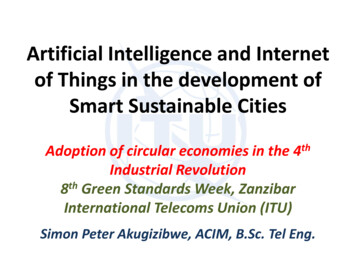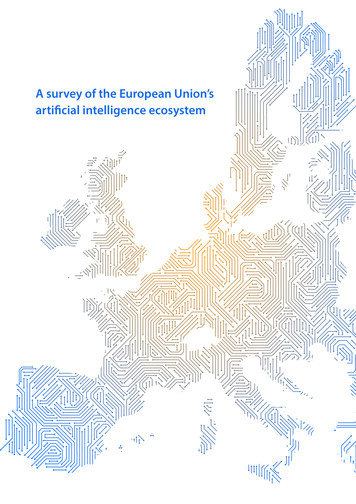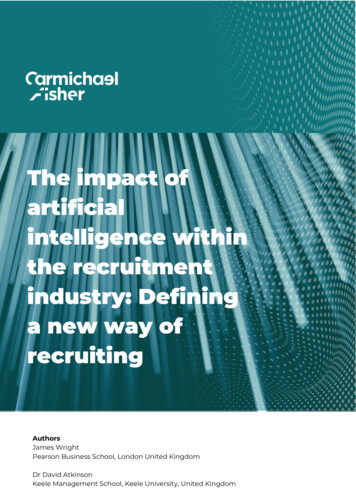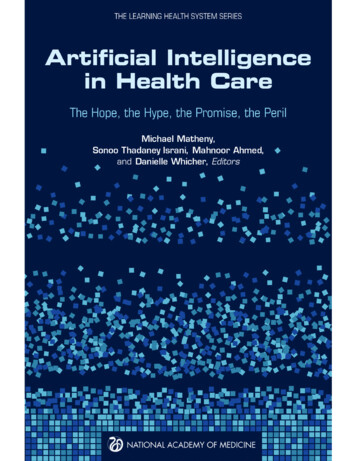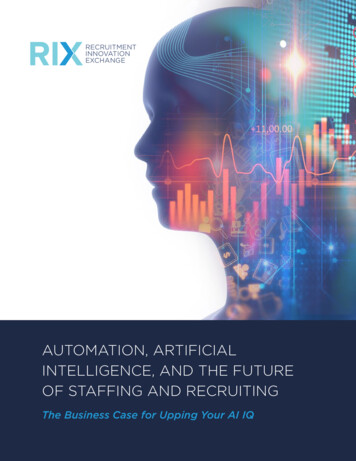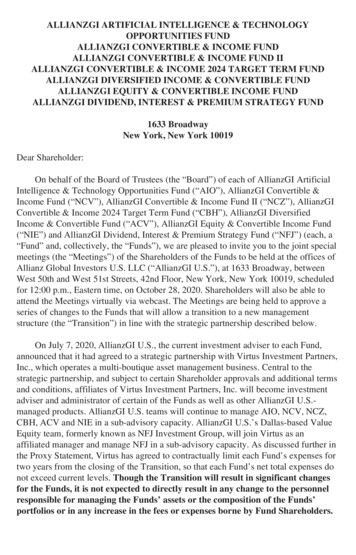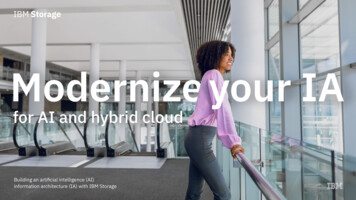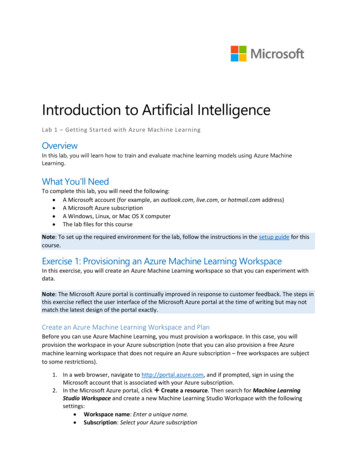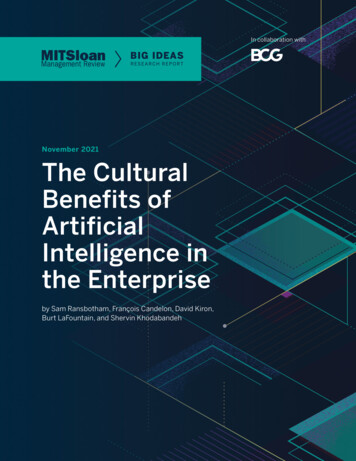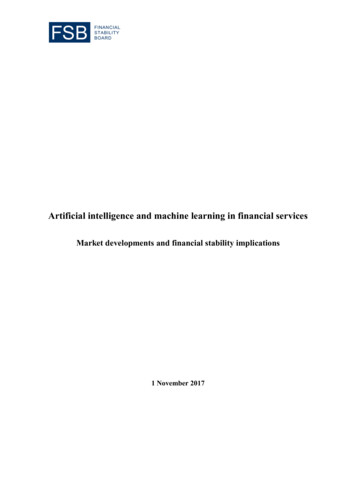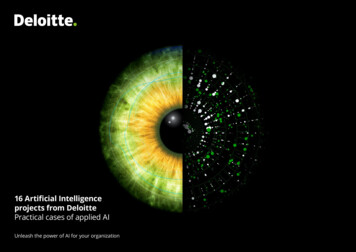
Transcription
16 Artificial Intelligenceprojects from DeloittePractical cases of applied AIUnleash the power of AI for your organization
16 Artificial Intelligence projects from Deloitte Practical cases of applied AITable of contentIntroduction5TAX & LEGALRISK ADVISORYTAX-I: your virtual legal research assistant10Using machine learning to assess risks for insurance policies28An AI benchmark study of transfer pricing12Predicting payment behaviour30SONAR: find labelling errors in databases14DocQMiner: contract analysis through AI31Transaction detector with regard to the Dutch work cost regulations16Eagle Eye: using the web for early detection of credit migrations32AUDITFINANCIAL ADVISORY SERVICESGRAPA: assistance with risk strategies18Combating welfare fraud with machine learning34Chatbot as a search tool for an online technical library20Using machine learning and network analytics to search for a needle in a haystack36Argus: an eye for detail21Clustering unstructured information in BrainSpace37CONSULTINGHR agent Edgy: the future of Human Resources24Virtual assistents: beyond the hype2603
16 Artificial Intelligence projects from Deloitte Practical cases of applied AI“ A computer would deserveto be called intelligent if itcould deceive a human intobelieving that it was human”Alan Turing04
16 Artificial Intelligence projects from Deloitte Practical cases of applied AIIntroductionAccording to some, artificial intelligence is the most promisingdevelopment for the future. From curing cancer to resolvingthe global hunger crisis, artificial intelligence is beingpresented as the solution to all of our problems. Others,however, regard it as a threat – artificial intelligence maypotentially give rise to unemployment and inequality, andcould even jeopardize the continued existence of humankind.As the technology entrepreneur Elon Musk put it: “The benignscenario is that artificial intelligence can do any job thathumans do – but better.”According to some, artificial intelligence isthe most promising development for thefuture. From curing cancer to resolving theglobal hunger crisis, artificial intelligence isbeing presented as the solution to all of ourproblems. Others, however, regard it as a threat– artificial intelligence may potentially give riseto unemployment and inequality, and couldeven jeopardize the continued existence ofhumankind. As the technology entrepreneurElon Musk put it: “The benign scenario is thatartificial intelligence can do any job that humansdo – but better.”Deloitte has positioned itself on the optimisticside of that spectrum. “We believe that artificialintelligence will be extremely helpful to usand to our clients”, says Richard Roovers, apartner at Deloitte Netherlands and InnovationLead Transformational Solutions North-WestEurope. Artificial intelligence will enable us tosolve problems that humans are unable, orhardly capable, of solving, explains Richard.“Artificial intelligence is capable of processingmassive quantities of data and has the abilityto discover patterns that even the smartestmathematicians are unable to find. That in itselfopens up a large number of new possibilities.”Those new possibilities are what this book isabout. The case studies provide an overviewof the ways in which Deloitte is working todevelop applications incorporating artificial05intelligence – both internally and for use withclients. The applications are diverse, make useof different technologies and can be found ina diverse range of industries. This shows thataside from all of the predictions for the future,artificial intelligence has already been a realityin the business sector for some time and formsa resource that could possibly provide yourcompany with a decisive lead.What is AI?Artificial intelligence (AI) is a collective termfor the science that is trying to make systemsintelligent. The definition, however, has notbeen definitely outlined: the type of behaviourby a computer that we regard as “intelligent” isshifting as technology achieves new advances.Systems that we would have called “intelligent”back in the 1980s – such as a smart lift systemor auto-navigation – have now become such aregular part of everyday life that some peopleno longer include them under the heading ofartificial intelligence.The British mathematician, Alan Turing (1912– 1954), was one of the pioneers in the fieldof artificial intelligence. According to Turing, “acomputer would deserve to be called intelligentif it could deceive a human into believing thatit was human”. That is the approach adoptedby the Turing test: people must be able to chatwith a human being and a computer program
16 Artificial Intelligence projects from Deloitte Practical cases of applied AI– neither of which can be seen – and then mustguess which one was the human and which onewas the machine. If the computer is selected,it has passed the Turing test and is therefore“intelligent”.The downside of that definition is that a humanjudgement is used as a reference. The resultsof Turing tests show that some people easilyassume that relatively unintelligent programsare actually intelligent. Other definitions ofartificial intelligence therefore emphasise theself-teaching methods and other advancedforms of data analysis that are used. In themeantime, a whole host of technologiesassociated with artificial intelligence have beendeveloped – the most important ones can befound in the list of terms.Why are we suddenly hearing so muchabout artificial intelligence?As an area of research, artificial intelligence hasbeen around for decades, but only in the pastfew years have things begun to develop at arapid pace. There are a number of reasons forthis.First of all, the advent of the internet andthe large-scale use of sensors generatedunprecedented amounts of data – in thecase of AI technologies, this was a significantdevelopment, as they are actually based onthe analysis of a large number of examples.Secondly, the emergence of cloud-basedservices massively simplified and increasedaccess to storage and computing power forbusinesses. This not only enabled complexcalculations to be carried out using all those06large quantities of data, but made it possible forapplications to be upscaled without restriction.“ At Deloitte,we don’t just talkabout AI, we do it”Finally, major technology companies arenow offering smart application programmeinterfaces (APIs). These make it possible toconnect to standardised AI applications andmake it much easier to develop applicationsutilising artificial intelligence. For example,if facial recognition is needed for an app, anAPI can be used instead of developing a facialrecognition algorithm for the individual appconcerned.All of these developments have led to asituation in which artificial intelligence hasreached a point that it is having a major impacton our everyday lives. Companies are startingto investigate applications on a large scale. Dueto the fact that major technology companiesin locations such as Silicon Valley are utilisingartificial intelligence in highly advanced ways,the business sector is coming under increasingpressure to innovate in that area. Customersare getting used to receiving guidance fromtechnology and are coming to expect that typeof service from other companies.How is Deloitte using AI?Deloitte is deploying maximum resources inthe area of artificial intelligence. That is why itrecently brought together all of its projects andinitiatives in the area of artificial intelligence intothe Artificial Intelligence Center of Expertise(AICE), in which hundreds of AI experts fromthe entire organisation are involved. Learningplays a key role, says Innovation Lead, RichardRoovers. “From a technical point of view, therecan be considerable overlap between the AIapplications being used in different industries.Take image recognition, for example – youcan use that technology for the automaticrecognition of installations on satellite images,but also in an app in order to detect skin cancer.Bringing people from different departmentstogether means that we can share knowledgeand accelerate learning.”Deloitte is keeping in touch with the AIexternal community by means of Meetups andhackathons. This enables the organisation tokeep up with the latest technical developments.Here too, it is a case of learning as much as can,as quickly as you can, says Roovers: “And we’renot only talking about AI, we’re doing it too. Weare experimenting, trying things out, attractingexperts and investing in technology. Only thenyou can you truly understand how and in whatcases you can use artificial intelligence in asensible way.”In order to innovate effectively, it isn’t simply acase of investing in technology, but of creatingsupport within the organisation as a whole.That is why Deloitte has launched an in-housecampaign in order to increase awareness as tothe possibilities offered by artificial intelligence– including amongst employees without atechnical background. In order to make anabstract concept such as artificial intelligencemore tangible, “AIME” the AI-robot wasdeveloped. In order to give staff an impressionof the potential offered by artificial intelligence,AIME was stood at the entrance to the Deloitteoffices and was active on social media.
16 Artificial Intelligence projects from Deloitte Practical cases of applied AIThe aim of this was to draw attention to artificialintelligence in an accessible way, explainsRoovers. “And it worked. Staff were surprisedand intrigued. They started conversationswith AIME and took selfies with her. Sheturned out to be a real conversation starter.”Our employees could then voluntarily signup for our “AI for dummies” course to learnmore about the subject. “The impetus wasconsiderable – even our CEO took part in thecourse,” continues Roovers.As far as the company is concerned, Rooversregards artificial intelligence as an opportunity,not a threat. “It’s true that artificial intelligencecan take over tasks previously carried out bypeople – and can even do them much morequickly and accurately. But the most importantpart of our business, the work that sets usapart from the others, lies in the contact wehave with our clients and in providing a tailormade service and those are things you simplycan’t outsource to an algorithm.” He goeson to point out that artificial intelligence canactually make our work more interesting. “Thedull, more repetitive work can be outsourced,leaving more time for the creative work thatenables we humans to make a difference.”As Roovers says, you can’t stand in the wayof change. The important thing is actually tounderstand how the world is changing andhow you can benefit from that as a company.07“In order to keep ahead of the rest, you haveto stick your head above the parapet. By usingartificial intelligence, we can continue to offerour clients the best possible service – and that’swhat it’s ultimately all about.”What types of solutions is AI able to offeryour company?The case studies in this book give animpression of the possible applications ofartificial intelligence. Amongst other things,AI technologies are used to improve serviceby means of chatbots, to avert cyberattacks,to trace potential fraudsters, to generatebenchmarking reports automatically, toestimate the risks that new customers pose toinsurance companies, to sort large quantities ofdigital evidence and much more besides.In short, the potential of artificial intelligenceis huge. Roovers: “The trick is to find outhow we can make it useable within our ownorganisation. On the one hand, we can do thatby creating smarter processes, but we can alsouse artificial intelligence to set up entire newproducts or services.”But where do you start? The first thing youneed is a knowledge of the technologies. Afterthat, it is possible to explore the possibilitiesthat exist within your own organisation andidentify opportunities and threats. After that,it’s a case of developing proofs of concept – andif those turn out OK, they can then be scaledup.Deloitte is able to assist with all of these steps:from exploring the possibilities to developingproofs of concept and long-term collaborationprocesses and co-creation. “Artificial intelligenceis no panacea”, warns Roovers. “It’s a caseof looking very carefully to identify preciselywhat problem you wish to solve and whattechnologies are available. In some cases, lessadvanced technologies are already sufficient tosolve the problem.”Thanks to the availability of APIs and cloudcomputing, however, developing a proof ofconcept is a relatively simple matter. “The nicething is that you can start small and if it works,you can quickly scale it up”, says Roovers.“There is such a lot you can do if you are smartwhen deploying artificial intelligence. Right now,we’re just at the beginning.”Using AI, companiesmay be able to get adecisive head start
16 Artificial Intelligence projects from Deloitte Practical cases of applied AIDefinitionsThere is a whole host of technologies that are associated with artificial intelligence.Here are just a few: Machine learning is a research field that is capable of recognising patterns in data anddeveloping systems that will learn from those. Supervised machine learning trains systems using examples classified (labelled) byhumans – for example: these transactions are fraudulent; those transactions are not fraudulent.Based on the characteristics of that classified data, the system learns what the underlyingpatterns of those types of item are and is then able to predict which new transactions are highlylikely to be fraudulent. Unsupervised machine learning is able to discover patterns in large quantities of unlabelleddata. It attempts to discover an underlying structure of its own accord, such as by clusteringcases that resemble one another and making associations. For example, retail companies areable to use purchasing data to recognise what products are often bought together and canadjust their o
The case studies in this book give an impression of the possible applications of artificial intelligence. Amongst other things, AI technologies are used to improve service by means of chatbots, to avert cyberattacks, to trace potential fraudsters, to generate benchmarking reports automatically, to estimate the risks that new customers pose to
